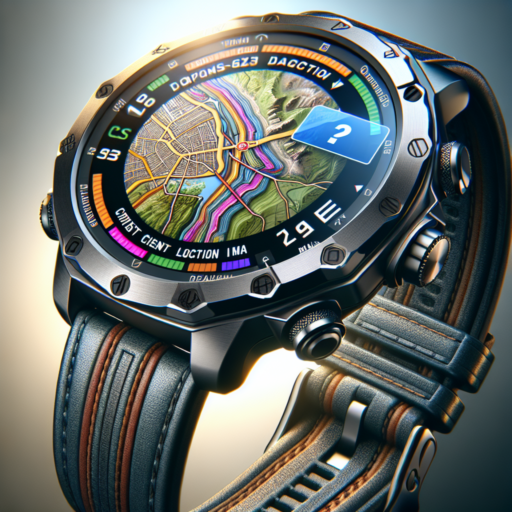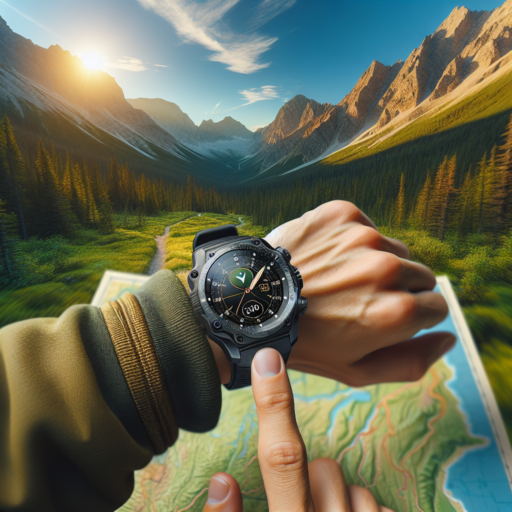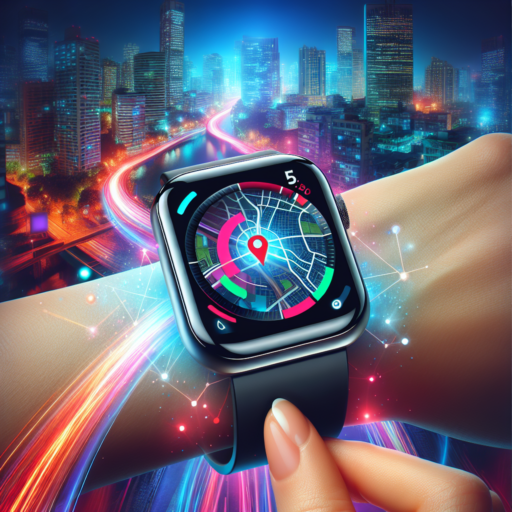Introduction to GPS Watches with Maps
In the realm of wearable technology, GPS watches with maps have carved out a significant niche for themselves, especially among outdoor enthusiasts and athletes. These sophisticated devices do not merely track your location but also enhance your navigation capabilities, making them indispensable companions for exploration and fitness activities.
The advent of GPS watches equipped with maps has revolutionized how we approach outdoor adventures. Whether you’re a seasoned hiker, a marathon runner, or someone who loves to explore, these devices provide comprehensive navigational tools right on your wrist. With the ability to display detailed maps, users can plot courses, set waypoints, and even retrace their steps if necessary.
One of the key features that set these watches apart is their real-time navigation capabilities. Users can see their position relative to their desired route, receive direction prompts, and get alerts if they veer off course. This level of interactivity ensures that adventurers can focus on the journey ahead, confident in the guidance their watch provides.
Top Features to Look for in a GPS Watch with Maps
When choosing a GPS watch with maps, several key features stand out to enhance your navigation and overall experience. These watches have evolved from simple step counters to sophisticated navigational aids that can keep you on track whether you’re exploring a city or trekking through backcountry trails.
High-Resolution Color Display
A high-resolution color display is crucial for easily interpreting maps and navigating through feature-rich interfaces. Such displays offer better visibility in various lighting conditions, making it easier to read your maps, waypoints, and other navigational data. Look for watches that offer customizable brightness levels to optimize battery life while ensuring readability in both bright daylight and dimmer conditions.
Long Battery Life
For those who love long-distance adventures or multi-day hikes, the importance of long battery life cannot be overstated. A GPS watch with extended battery life ensures that you can navigate, track your activities, and monitor your performance without the constant worry of recharging. Some of the best models offer battery-saving modes, allowing you to extend the watch’s life significantly when you’re far from a power source.
On-Device Navigation and Mapping Functions
The core of a GPS watch with maps is its on-device navigation and mapping functions. These features enable you to plot courses, set waypoints, and follow routes directly from your wrist. Look for watches that support real-time bread-crumbing, allowing you to trace your steps back to your starting point—a critical feature for safety during off-trail excursions. Additionally, preloaded topographic maps, the ability to add custom maps, and live tracking capabilities greatly enhance the usefulness of your GPS watch in diverse environments.
Remember, when choosing a GPS watch with maps, it’s essential to consider how you plan to use it. Features like a touchscreen interface for easier map interaction or the compatibility with various satellite systems for more accurate location tracking might also be important based on your specific needs.
Comparing the Best GPS Watches with Maps for 2023
In the rapidly evolving world of wearable technology, GPS watches have become indispensable gadgets for outdoor enthusiasts and athletes alike. The 2023 lineup promises even more advanced features, particularly in navigation capabilities. When comparing the best GPS watches with maps for this year, several key factors stand out that elevate the user experience and performance.
Firstly, display quality and interface intuitiveness play crucial roles in how effectively users can access and interpret map data. The top contenders in this category boast high-resolution, color displays that remain perfectly legible under direct sunlight. These watches also feature user-friendly interfaces that allow for smooth zooming and scrolling through maps, making it easier for adventurers to stay on track.
Battery life is another paramount consideration. The leading GPS watches of 2023 have pushed the boundaries of power efficiency, offering extended use between charges even when in full GPS mode with mapping features activated. This endurance is vital for long treks and expeditions where charging opportunities are scarce, ensuring that explorers can rely on their device throughout their journey.
Enhanced Connectivity and Smart Features
Furthermore, the integration of smart features and enhanced connectivity options distinguishes the best models. These watches not only provide detailed map overlays but also offer live tracking, weather updates, and the capability to sync with various external sensors. This symbiosis between GPS mapping and smart functionalities enriches the user’s experience, providing a comprehensive toolkit for navigation and fitness tracking.
In summary, when comparing GPS watches with maps for 2023, the emphasis is on display clarity, interface ease-of-use, battery longevity, and the integration of smart features. The advancements in these areas are what make the latest models stand out, assisting users in navigating the great outdoors with confidence and precision.
How GPS Watches with Maps Can Enhance Your Outdoor Adventures
Navigating the great outdoors has transformed dramatically with the advent of GPS watches that offer integrated mapping features. These wrist-bound marvels are not just about telling time or tracking your fitness; they’re powerful tools that enhance the way we explore nature. With comprehensive maps right at our fingertips—or more accurately, on our wrists—adventurers can venture into the unknown with a newfound confidence and safety.
One of the standout benefits of GPS watches with maps is their ability to provide real-time location tracking and navigation. This means you can see precisely where you are on a detailed map, understand the terrain ahead, and plan your route accordingly. Whether you’re hiking through dense forests, scaling remote mountains, or traversing vast deserts, these devices ensure you’re always aware of your surroundings and can help prevent getting lost.
Beyond the basics of navigation, GPS watches equipped with mapping functionalities boast a range of additional features designed to improve your outdoor experiences. These might include the plotting of waypoints to mark points of interest, the ability to track your route and share it with others, and even weather alerts to keep you informed of changing conditions. For those who revel in exploring new terrains, these watches act as a digital guide, offering peace of mind and enriching your adventure through detailed geographic insights.
Setting Up Your GPS Watch with Maps: A Step-by-Step Guide
Setting up your GPS watch with maps is a straightforward process that empowers you to navigate your surroundings like a true explorer. Whether you’re hiking through unknown trails or navigating the city’s hustle and bustle, the integration of maps into your GPS watch can significantly enhance your outdoor experiences. Let’s delve into the essential steps you need to follow to seamlessly upload and manage maps on your device.
Step 1: Compatibility Check
First and foremost, it’s crucial to ensure that your GPS watch is compatible with map integration. Most recent models are, but verifying this information can save you time and effort. Visit the manufacturer’s website or consult the user manual to find out if your device supports maps and which formats are compatible. This initial step paves the way for a smooth setup process, ensuring that your device can indeed transform into a navigational companion.
Step 2: Installing Mapping Software
Once compatibility is confirmed, the next step involves installing the necessary software or app that allows you to manage the maps on your GPS watch. Typically, manufacturers offer proprietary programs designed to facilitate this process, such as Garmin Express or Suunto Movescount. Download and install the application on your computer, and ensure your device is fully charged before proceeding to the next steps. This stage is critical for a hassle-free experience in managing the maps and firmware updates for your GPS watch.
Step 3: Downloading and Syncing Maps
With the software installed, you’re now ready to download and sync maps to your GPS watch. Open the application and connect your watch to your computer via USB. Once detected, you can browse through the available maps and select the ones relevant to your activities or destination. After selecting, the software will typically offer an option to ‘sync’ or ‘send to device,’ initiating the transfer of maps to your watch. Remember to wait for the process to complete before disconnecting your watch to ensure a successful setup.
The Technology Behind GPS Watches with Maps: How It Works
The marvel of GPS watches with maps lies in their intricate combination of hardware and software, working seamlessly to keep us on track. At the core of these advanced devices is the Global Positioning System (GPS), a network of about 24 satellites orbiting Earth. These satellites send signals that GPS watches decode to pinpoint the user’s precise location. However, the technology that empowers these watches goes well beyond simple location tracking.
Signal Reception and Triangulation: The first critical component in the technology behind GPS watches with maps is their ability to receive signals from multiple satellites. By accessing at least four satellites, a GPS watch can use triangulation to determine the wearer’s exact position on Earth. This process calculates the distance between the watch and each satellite, using the time it takes for the signals to travel. The accuracy of this technology is astounding, often pinpointing your location within a few meters.
Integration with Maps: Once a GPS watch has determined your location, the magic of navigation begins. Modern GPS watches are equipped with preloaded maps or allow maps to be downloaded, integrating detailed geographical data with the user’s current position. This integration enables features such as real-time tracking, route planning, and navigational prompts. Users can explore unknown regions or plot specific courses, all while monitoring their progress directly from their wrist.
Maximizing Battery Life in GPS Watches with Maps
Maximizing the battery life of your GPS watch with maps is crucial for outdoor adventurers and athletes who rely on long-lasting performance. GPS watches with mapping capabilities are incredibly powerful tools, but their advanced features can often lead to rapid battery depletion. Understanding how to effectively extend your device’s battery life can ensure that your adventures are uninterrupted and more enjoyable.
Adjusting Settings for Optimal Battery Usage
To get the most out of your watch’s battery, start by tweaking certain settings. Dimming the screen brightness, minimizing the frequency of GPS updates, and disabling Bluetooth when it’s not needed can significantly reduce power consumption. Watches often come with various battery modes and customizing these can help you find the perfect balance between functionality and battery efficiency.
Utilizing Battery Saving Features
Many GPS watches with maps offer battery saving modes specifically designed to extend battery life during use. Activating these features can sometimes reduce the detail of maps or slow down the update rate, but the trade-off is often worth it during long activities. Regularly updating your watch’s software can also ensure that you’re benefiting from the latest battery optimization technologies.
Remember, the key to maximizing the battery life of your GPS watch lies in balancing the use of its powerful mapping features with strategic adjustments and settings. By doing so, you can enjoy the full potential of your device without the constant worry of a depleted battery.
Understanding the Accuracy of GPS Watches with Maps
GPS watches have revolutionized the way we navigate, exercise, and even find our way back home. Yet, a question often arises regarding the accuracy of GPS watches with maps. How precise are these devices when tracking our location or guiding us through unfamiliar terrains? This is a question that encompasses both technology and user experience.
The accuracy of GPS watches can vary significantly based on several factors. One of the main considerations is the quality of the GPS technology used in the watch. Modern GPS watches incorporate advanced technology designed to improve location tracking. However, environmental factors such as tall buildings in urban areas, dense foliage in forests, or deep valleys in mountainous regions can interfere with GPS signals, affecting the device’s ability to provide accurate readings.
Another vital aspect to consider is the mapping software integrated into the GPS watch. High-quality mapping software can greatly enhance the accuracy of GPS watches by providing more detailed and up-to-date maps. This software can help in identifying the most accurate and efficient routes, thereby improving the overall functionality of the GPS watch. Additionally, some GPS watches come with features like GLONASS or Galileo support, which can help in improving location accuracy by using multiple satellite systems.
Troubleshooting Common Issues with GPS Watches with Maps
Dealing with issues in GPS watches featuring maps can be frustrating, especially when you rely on them for navigating your outdoor adventures. Common problems range from inaccurate tracking to difficulty loading maps. Understanding how to effectively troubducehoot these issues can ensure a smoother and more reliable experience with your device.
Inaccurate GPS Signal
One of the most prevalent issues with GPS watches is inaccurate GPS signals. This can often be resolved by ensuring your device’s firmware is up to date. Additionally, before starting your activity, make sure to wait for your watch to acquire a full GPS signal. This might take a few minutes, especially in areas with dense coverage like urban environments or deep valleys. If problems persist, consider resetting your GPS data, a function commonly found in the settings menu of most devices.
Maps Not Loading Properly
Another common issue is maps not loading or displaying incorrectly on your GPS watch. This can be due to a lack of memory space, corrupt files, or outdated map software. Start by checking if there is enough free memory on your device for maps to operate smoothly. If memory space isn’t the issue, try reinstalling the map software. Remember to back up any important data before conducting a factory reset, as this could be your last resort to resolve persistent map loading issues.
In conclusion, while troubleshooting GPS watches with maps can seem daunting, simple steps such as updating software, ensuring adequate signal acquisition time, and managing device memory can significantly mitigate common problems. For more complicated issues, consulting the manufacturer’s website or reaching out to customer support can provide tailored solutions.
No se han encontrado productos.
Future Trends in GPS Watches with Maps Technology
The evolution of GPS watches with maps technology is set to redefine the way we navigate and interact with our environments. As technology advances, these devices are becoming more than just navigational tools; they are transforming into comprehensive fitness and lifestyle gadgets that offer a myriad of functionalities tailored to the needs of outdoor enthusiasts, athletes, and everyday users alike.
Integration of Augmented Reality
One of the most anticipated future trends in GPS watches is the integration of augmented reality (AR). This technology will allow users to view their routes and maps overlaid onto the real world through their watch display or connected smart glasses. This innovative approach will not only enhance navigation but also improve safety and engagement by providing real-time data and visual cues about the surrounding environment.
Enhanced Customization and Adaptability
As personalization becomes increasingly important to consumers, future GPS watches with maps will likely offer more customizable maps and routes. Users will be able to tailor their devices to their activity or preferences, whether they’re hiking, cycling, or exploring urban environments. Additionally, with machine learning and AI technologies, these watches will adapt to the user’s habits and preferences, suggesting routes and activities based on their past behavior and fitness goals.
Increased Connectivity and Social Features
Finally, the next generation of GPS watches is expected to feature enhanced connectivity options and social features. Users will be able to share their location, routes, and achievements with friends and family in real-time. This social integration can foster a sense of community among users, encouraging more outdoor activities and healthy competition. Furthermore, with improved battery life and more efficient power consumption, these devices will allow for longer adventures without the need for frequent recharging.




